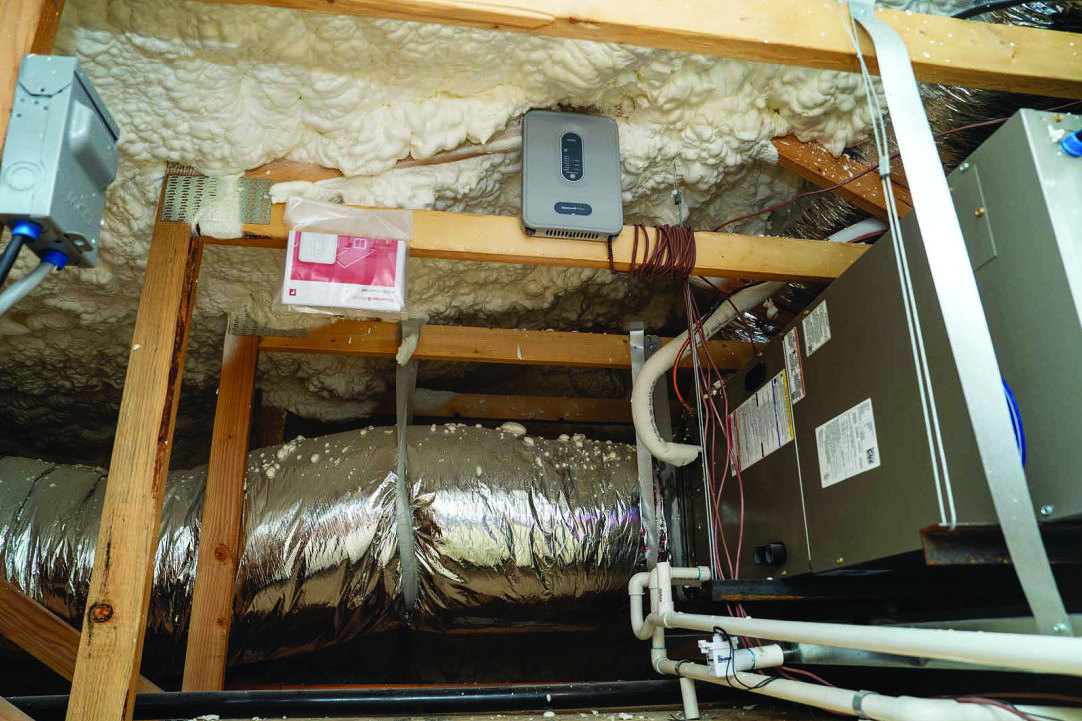
Touchstone Living uses heavy insulation foam in houses’ attics, keeping air-conditioning units from working too hard.

DEVELOPMENT
The houses in Las Vegas’ Solaris community might not look much different than other homes, but they hold some hidden and not so-hidden features that can set them apart.
From solar panels on the roof to thick insulation in the walls and state-of-the art appliances, these homes are built with a focus on energy efficiency. Case in point: Solaris developer Touchstone Living uses extra-thick foam insulation to help keep the temperature down in the attic during sweltering desert summers.
Otherwise, “it’s literally 150 degrees up there,” said Danny Topol, vice president of construction for Touchstone.
The process starts before electrical wiring or plumbing has been installed, with slabs of insulation inserted in the walls and under the stairs, Topol explained. Thick acoustical sealant fills every potential gap between the floor and walls, and every protruding light, fire alarm or fire sprinkler will be sealed to prevent air from leaking out.
“When you get an older home and you see dust coming in under your baseboards, you go ‘How did that get there?’” Topol said. “It’s coming from the exterior of the home.”
Additionally, the windows are double-paned, with argon gas injected between the two panes to act as a thermal insulator. On those 100-degree summer days in Las Vegas, the windows will only be mildly warm to the touch, he said.
While such energy-saving features save money over time, the downside is that they drive up the initial price of the house.
In the Solaris community, near the 215 Beltway and Russell Road, prices range from $344,990 to $400,000 for a house between 1,165 and 1,183 square feet.
“Especially because we service the first-time buyer, the challenge for them is if they can’t get in because (the house is) too expensive, then all the savings we’re putting together on the ownership side of things are never realized,” said Tom McCormick, president of Touchstone Living.
Nonetheless, there is a nationwide push for more energy-efficient homes. In a letter last March, a group of consumer and mortgage lenders urged the Federal Housing Finance Agency to require all homes they finance to follow the 2021 International Energy Conservation Code.
“While the lenders represented here have various positions with respect to addressing both climate impacts and resilience, this proposal will have the added benefit of helping to reduce emissions from the built environment, advancing both corporate and governmental commitments to prudent climate action, and increasing survivability in homes in extreme weather events,” the letter states.
Last year, the Department of Agriculture and Department of Housing and Urban Development said adopting more stringent international codes would not make homes less affordable because their higher energy efficiency would offset the construction cost over time.
According to the U.S. Office of Energy Efficiency and Renewable Energy, more than half the country still uses codes establishedin2009.
Las Vegas adopted the 2018 International Energy Conservation Code, and Clark County adopted the2021codelastyear.
The code requires insulation installers to provide certification of each house’s efficiency and requires at least 90% of lighting fixtures to be high-efficacy lamps.
Some newer housing developments exceed standards with heavy insulation, better appliances, more efficient heating and cooling systems, and solar energy systems.
As building codes require more efficient construction, the gap between the efficiency of old and new construction grows.
Marco Velotta, Las Vegas’ chief sustainability officer, said energy efficiency codes became more stringent in the 1990s, and thenagainin2006and2009.
“There’s been more emphasis on increasing overall building energy efficiency, and there have been some corresponding changes for residential requirements,” Velotta said.
Those mostly have to do with ventilation, air circulation, insulation, windows and ducts, he said.
Older homes, built to less stringent standards and from outdated materials, will never reach the same level of efficiency of Touch stone’s new houses.
The Nevada Clean Energy Fund’s Re-Up program offers loans to homeowners for upgrades for items such as insulation, air-conditioning units and windows.
“We usually estimate that those types of improvements will reduce energy bills by at least 15%,” said Will Pregman, the program manager.
The program has received more than 50 applications, and has secured loans for about nine homeowners, he said. The program’s maximum loan limit is up to $50,000, which can cover a large solar power system installation.
rhiannon.saegert@gmgvegas.com / 702-948-7836 /@musettasun

